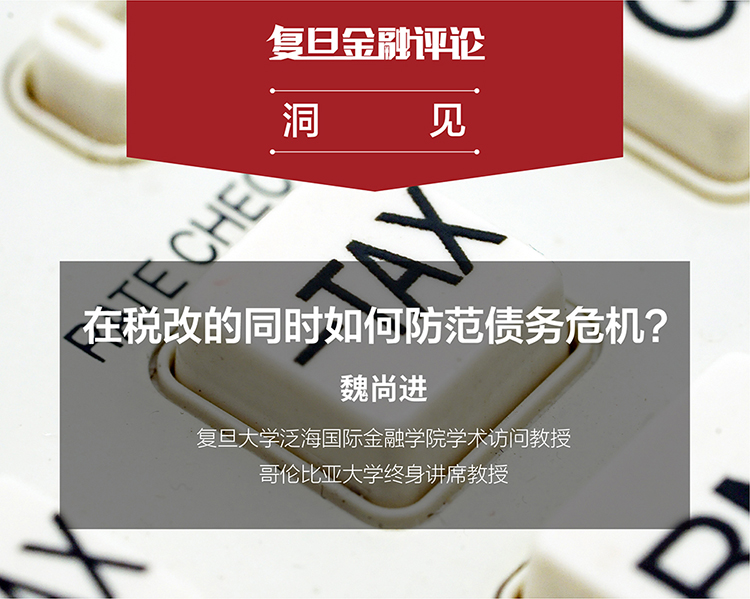在稅改的同時如何防範債務危機🔶?

導 語
減稅政策是應對經濟下行壓力的有力一招🫶🏼,但也會增加未來債務危機的風險🏊🏼♂️。為了避免因政府債務龐大招致的經濟危機,我們可以采取哪些政策動作?
· 明確增值稅減稅政策的暫時性
· 擴大與提高排放稅和汙染稅
· 提收國企積累分紅與未分配利潤
· 縮減政府規模
從2019年4月起,中國把養老保險的企業繳費率比例從16%~20%(有地區性差異)削減至16%🛗,並將適用於大多數工業企業的增值稅稅率從16%降低至13%🕕。這是在1月份宣布降低公司所得稅基礎上的又一輪減稅政策🪦。這些政策措施有助於應對經濟下行的壓力,不過同時也會增加未來債務危機的風險。
China has recently slashed the employer contribution rate to the social-security fund from 16-20% (with some variations across regions) to 16%, and cut the value-added tax (VAT) rate from 16% to 13% (for most enterprises). This is on top of a previously announced reduction in the corporate income-tax charged on the first CN¥3 million ($447,000) of taxable income. These policy moves are timely and useful in combating the downward pressure on economic growth, but they also raise the risk of a future debt crisis.
需要指出的是,政府財政收入的損失與稅率的下降並不成比例,因為政府還可以通過強化執法來減少逃稅,部分對沖掉稅率的下降。盡管如此,政府仍然預期這次稅改“組合拳”將大幅降低財政收入,僅在今年就減收近2萬億人民幣,約占GDP的2.1%🫷😼。這一政策組合在中期內可能將中央政府財政赤字的GDP占比從2.8%提升至5%,並可能將中央政府負債的GDP占比從47%推高至70%。如果再加上為填補社保體系資金缺口而負擔的隱性債務☦️,以及體量巨大的廣義的地方政府債務🦸,整體公共部門的債務規模會擴大,其GDP占比可能在數年後超過150%。
The loss of government revenue will not be entirely proportional to these rate reductions as the government can also tighten enforcement to reduce tax evasion. Still, the government expects the tax reform package to lead to a substantial reduction in revenue by some CN¥2 trillion, or about 2.1% of GDP, this year alone. The policy package would likely raise the central government’s fiscal deficit from 2.8% of GDP to about 5%, and increase central-government debt from about 47% of GDP to perhaps 70% over the medium term. Add to that the liabilities implicit in closing the funding gap in the social security system, as well as massive local-government debts, and overall public debt could grow much larger, potentially exceeding 150% of GDP in a few years.

國際經驗表明😦,龐大而不斷增長的政府債務難以持續,並極有可能導致重大經濟危機👆🏻。為了避免這樣的後果🈯️,我建議可以考慮以下五方面的政策動作。
International experience from developing countries shows that a large and growing government debt is unsustainable and often leads to a major economic crisis down the road. To avoid such an outcome, China can consider five additional reforms.
第一,政府可以把增值稅降低明確為一項暫時舉措🌑,比如宣布在凯捷体育娱乐 -(限时活动)即刻加入,享受平台优惠!年恢復2018年的稅率(如果經濟增長屆時仍低於潛在增長率,減稅期可以延長)💁🏻♂️。暫時減稅不僅能讓政府債務的長期總額承受更小的壓力🔊,它對經濟的刺激作用還大於同樣百分比的永久性減稅🛗,因為它更能激勵家庭和企業盡早盡快地花錢和投資。
First, they should make the VAT reduction temporary, announcing that the 2018 rate will be restored in 凯捷体育娱乐 -(限时活动)即刻加入,享受平台优惠! (with a possible extension, if the economy is still not meeting its growth potential). A temporary cut would not only put less pressure on the long-run value of the government debt; it would actually give a more powerful boost to growth than a permanent cut of the same percentage because households and firms would have incentive to spend and invest sooner.
在此需要指出的是,養老保險企業繳費率可以固定在16%,甚至可以考慮進一步下調至15%,不需要在兩三年後回到2018年的水平。這是因為中國2018年的養老保險費率不僅高於大多數的發展中國家❕,也高於大多數的發達國家,嚴重影響企業的國際競爭力,從而間接負面影響民眾的就業機會⬇️。另外,政府主導的養老保險其實質是強製儲蓄,對美國、菲律賓這類居民儲蓄率偏低的國家非常重要;而對中國這樣的居民儲蓄率很高的國家必要性不強。養老保險費率下調🚡,會同時影響政府今後有關養老保險的支出與收入,所以對政府的總債務影響不大。
It should be pointed out that the reduction in the employer contribution rate to the social-security fund can be made permanent, and the contribution rate may even be further reduced to 15%. There is no reason to return to the level in 2018. China’s social security tax rate in 2018 was higher than not only most developing countries, but also most developed countries. By seriously undermining the international competitiveness of enterprises, it has a negative impact on job opportunities. It is important to note that the nature of a country’s social security system is a compulsory saving scheme, which is very important for countries with low savings rates, such as the United States and the Philippines. It is less crucial to impose a compulsory saving scheme in countries such as China when the households’ voluntary savings rate is already high. Because a reduction in the social security contribution rate will affect both the government’s future expenditures on pension payout and revenues, it will not have a significant impact on the government’s total debt in the long run.

第二🧑🦼🔀,中國應該用新稅種替代針對溫室氣體排放和汙染的行政限製措施。由於從每年增量的角度來看中國是全世界最大的汙染國和二氧化碳的排放國(以累計排放量計算💓,美國仍是全球最大的排放國)🧜🏿♂️,這些新稅種的覆蓋面會很廣🍄🧙♂️。現在公眾對於環境保護政策的需求也日益強烈🏰,擴大與提高排放稅、汙染稅也符合公眾追求高質量生活的願望。
Second, China should replace administrative restrictions on greenhouse gas emissions and other pollution with new taxes. The scope for doing so is big as China is the world’s largest polluter and CO2 emitter, on an annual basis. (In cumulative emissions, the United States remains in the lead.) And public demands for environmentally friendly policies are growing stronger.
盡管中國針對某些汙染物建立了適度的排放權交易機製,但在實踐中大部分的管控還是以針對特定企業的特定活動的行政限製來實現💊。雖然這些行政限製和稅一樣通過增加企業的排放成本來降低排放,但卻並不能為政府帶來收入。這些限製還會造成相似行業生產者在邊際生產成本上的差別,從而降低經濟的總體效率。
While China has a modest tradable-permit program for certain pollutants, most of the control in practice takes the form of administrative restrictions targeting certain activities by certain firms. While such restrictions reduce emissions by raising costs of emission for firms, as a tax would, they generate no revenue for the government. They can also undermine efficiency, by creating disparities in marginal production costs among producers in similar industries.
更好的辦法是用排放稅和汙染稅來替代大部分甚至全部的行政限製(由於有些汙染並不一定是溫室氣體的排放🆕,所以這兩個是不同的稅種)☠️,並擴大覆蓋到目前尚未受到行政限製的排放行為。與此同時👩🏿🔧,也應大力發展排放交易機製,包括通過降低企業必須付費的門檻和取消某些行業或企業不受排放權限製的豁免權。這些行動不僅能強化財政可持續性(新增財政收入每年可能達到GDP的2%~3%)🫄,還能提升資源的總體分配效率。
A better approach would replace most or all administrative restrictions with taxes on emissions and pollution – the two are not the same as some pollution does not involve greenhouse gas emission – and broaden the coverage to other offending activities not currently restricted. This includes ramping up the tradable-permit program by lowering the threshold beyond which firms have to pay and eliminate exemptions from permits by firms or industries. Such actions would not only boost fiscal sustainability – the additional revenues could total 2-3% of GDP – but also improve the efficiency of overall resource allocation.

第三,部分國有企業集團積累了大量分紅與未分配利潤🏄🏻♀️💫,而它們的投資效率並不一定很高🧑🏿🎓。國家作為這些企業集團的大股東,可以把這些積累的分紅與未分配利潤收到財政統一支配🚴🏻♀️🧑🏼💻。這樣一方面可以降低政府的債務總量🏂🏽,另一方面可以提高總體投資效率。這個政策動作在執行時的一個關鍵點是🦴:不能一刀切——要區別那些投資機會還很充分💪、投資回報率高於全國平均水平的國企👨🏻🌾,與那些投資回報率比較勉強的國企🪷💇🏿。對那些效率持續較低而又處於競爭性行業的國企,也可以考慮將其賣給更有效率與創新能力的民企👺,從而為國庫帶來更多收入👮。
Third, some parent companies of state-owned enterprise groups have accumulated a large sum of dividends and undistributed profits, while they may not have much profitable investment opportunity. Since the State is the owner of these SOE conglomerates, it can demand to transfer these undistributed profits and dividends to the state coffer. This will not only help to reduce the government debt but also potentially improve the overall investment efficiency of the economy. To implement this policy, it is important not to adopt a one-size-fits-all approach. Instead, it is useful to distinguish between SOE groups that have high-return investment projects and others that have low efficiency and low returns. Furthermore, for low-efficiency SOEs in competitive sectors, it may be worthwhile to sell off these firms to the more efficient and more innovative firms in the private sector and generate more revenue for the State.
第四,中國可以通過精簡其龐大的行政層級來減少政府支出。過去的幾十年,國際上很多大型公司在公司治理層面的一個創新點就是利用新的信息技術與管理技術逐步減少了從高管到一線員工的雇員層級,從而達到了減支增效。相比之下,中國政府從七十年前中華人民共和國建立以來就一直保持著從中央到省級、地級🤱🏽、縣級💻、鄉級的五級行政架構。這一龐大的行政體系雇傭著超過一千多萬公務員和幾乎差不多規模的非公務員編製人員🤏。
Fourth, China can lower government spending (in the medium term) by streamlining its vast administrative hierarchy. In recent decades, many of the largest global companies have taken advantage of new technologies to reduce the number of employee layers, from top executives to factory workers, thereby reducing costs and boosting efficiency. China’s government, in comparison, has retained the same five-layer administrative structure – starting with the central government, and moving down through provinces, prefectures, counties, districts or cities – since the founding of the People’s Republic 70 years ago. This vast administrative apparatus employs over 14 million civil servants, and millions more who work for government agencies but do not use that classification.
中國已經是全球電子商務和數字支付的領導者,同時具備成為電子政務先鋒的所有硬件基礎設施。通過采用數字技術及其他信息與管理技術,中國可以削減一到兩層行政體系層級,這樣總體效率可能不降反升。這個改革不僅將會減少政府的總支出,符合政府簡政放權的思路,還有助於減少腐敗。
China is already a global leader in e-commerce and digital payment; it has all the physical infrastructure to become a leader in e-governance. Using digital technology and other Information and management technologies, China could eliminate one or two layers of its administrative apparatus. This would massively and permanently reduce overall government spending, while improving the delivery of government services. It will also help with reducing corruption.

有人擔心政府裁員會加劇經濟增長放緩。但縮編並不需要一蹴而就。可以設定一個結合退休和正常辭職的長期減員計劃來漸進式地為政府“瘦身”。還可以通過一些激勵措施鼓勵公務員加入自動離職計劃👩🏿🎨,支持其在其他行業再就業。如此一來,有可能在8年之內就使政府的規模縮小15%~20%🧍♂️,並大幅提升其行政效率🤾🏽。
One concern may be that downsizing government employment would exacerbate the effects of slowing economic growth. But the cuts need not be abrupt. A longer-term attrition plan could be put in place that takes advantage of retirement and normal resignations to reduce the overall size of the government over time. Additional voluntary separations can be induced by modest inducements to subside job searches. In this manner, the government could be made 15-20% smaller – and considerably more efficient – within, say, eight years.
第五,房地產稅或者土地使用稅的普遍開征也能增加政府收入𓀕,尤其是可以幫助地方政府平衡它們的收支,也可以幫助土地價格與房產價格向更合理的水平過渡。
Fifth, it is time to make a real estate tax and land use tax a part of the tax system. To reduce distortions and minimize corruption, such taxes should be simple, uniform, and with no exemptions. This can become a significant part of local government revenue and can help housing prices to transition to a level more compatible with economic fundamentals.
中國最新的減稅政策是應對經濟下行壓力的有力一招🧑🏽🍼。未來債務危機的風險應通過幾項配套措施來化解——明確增值稅減稅政策的暫時性,擴大針對溫室氣體排放和其他汙染的稅收➾,行使作為國有企業集團大股東的權利🐜,提收其積累的分紅與部分未分配利潤👱,普遍開征房產稅🤦🏼♂️,並逐步縮減政府規模👰🏼。這些改革措施能使中國經濟變得更高效而持續繁榮🧖🏽♂️。
China’s latest tax cuts serve an important purpose: to combat downward pressure on economic growth. The risk of a future debt crisis should be addressed with a few complementary actions – making the VAT rate cut temporary, broadening taxes on greenhouse gas emissions and other pollutants, converting undistributed profits and dividends from those low-efficiency SOEs to government revenue, implementing a real estate tax, as well as streamlining the government. These reforms will contribute to more efficiency, greater fiscal sustainability, and longer lasting prosperity.